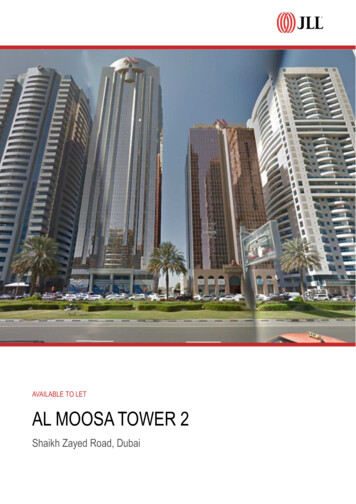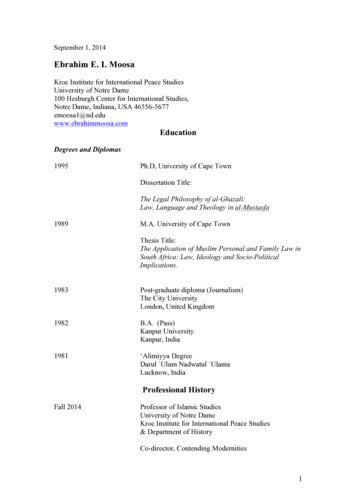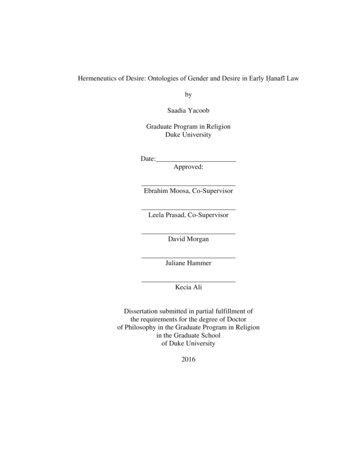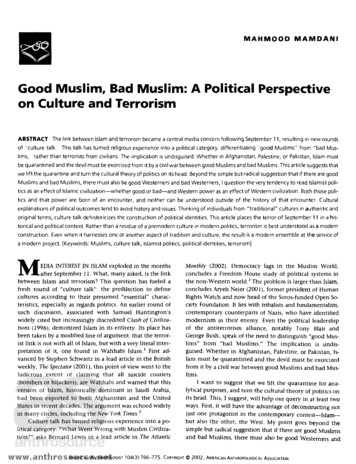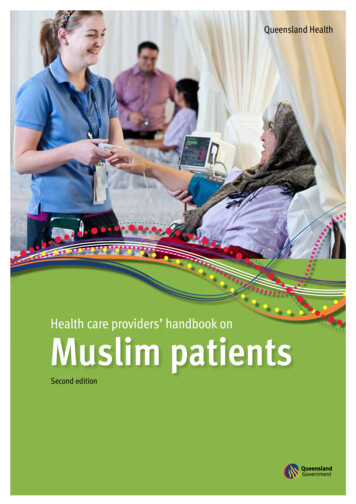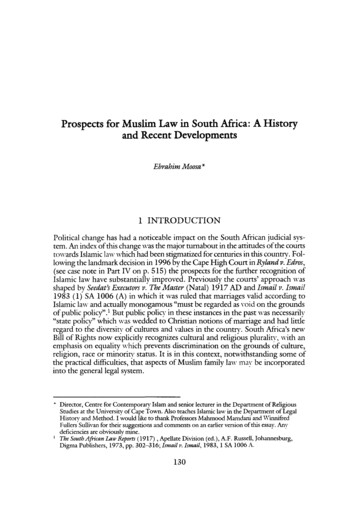
Transcription
Prospects for Muslim Law in South Africa: A Historyand Recent DevelopmentsEbrahim Moosa*1 INTRODUCTIONPolitical change has had a noticeable impact on the South African Judicial systern. An index of this change was the major turnabout in the attitudes of the courtstowards Islamnic law which had been stigmatized for centuries in this country. Following the landmark decision in 1996 by the Cape High Court in Ryland v. Edros,(see case note in Part TV on p. 515) the prospects for the further recognition ofIslamic law have substantially improved. Previously the courts' approach wasshaped by Seedat's Executors v. The Master (Natal) 1917 AD and Ismail v. Ismail1983 (1) SA 1006 (A) in which it was ruled that marriages valid accordig toIslamic law, and actually monogamous "must be regarded as void on the groundsof public policy".I But public policy in these instances in the past was necessatilv"cstate policy" which was wedded to Christian notions of martiage and had littleregard to the diversity of cultures and values in the country. South Africa's newBill of Rights now explicitly recognizes cultural and religious plurality, with anemphasis on equality which prevents discrimination on the grounds of culture,religion, race or minority status. It is in this context, notwithstanding some ofthe practical difficulties, that aspects of Muslim family law may be incorporatedinto the general legal system.Director, Centre for Contemporary Islam and senior lecturer in the Department of ReligiousStudies at the University of C ape Town. Also teaches Islamic law in the Department of LegalHistory and Method. I would like to thank Professors Mahmood Mamdani and WinnifredFullers Sullivan for their suggestions and comments on an earlier version of this essay. Anydeficiencies are obviously mine.The South African Law Reports (1917) , Apellate Division (ed.), A.F. Russell, Johannesburg,Digma Publishers, 1973, pp. 302-316;I1srail v'.Ismail, 1983, 1iSA 1006 A.130
Prospectsfor Muslim Law in South Africa11131Bearing in mind that in all societies law is "one of the most explicit, concreteand institutionalized cadres of ethno-sociological discourse", it is appropriate toprovide a detailed description of the history of Muslim law in South Africa. 2 Thosewho engage in legal history for the purpose of furthering a linear progress inpolicy or theory "tend to view legal history in isolation from other cultural developmuents, an isolation that often precludes insight into the deeper meaning oflegal change." 3 In order to ascertain the various domains of law outside of statelaw, in this case Muslim law, it is crucial to ponder on the politics of Muslim lawand the social function of religious law in a multicultural and differentiated secular political context.Contrary to the perception of outsiders, the religious and political tapestry ofthe Muslim comnmunity in South Africa is rich, diverse and differentiated. 4 Islammay have -arrived here as early as 1658 when the Dutch brought somne of their subjects from their colonies in the Malay archipelago to the Cape. However, there isdefinite evidence that by 1667 a steady stream of political prisoners, convicts andslaves from South-east Asia made up thie core of the earliest Muslim community.Later, in the middle of the nineteenth century, Indian indentured labourers importedto work on the sugar plantations of the British colony of Natal made up the second ethnic component of Islam. Conversion to Islam from members of the indigenous African comnmunities and the European conmmunities make up the othertwo ethnic elements of Islam. Today the numbers of Muslims are estimated to bebetween 0.5 to 1 million in the absence of accurate census figures. Most Muslimsare members of the Sunni' creed and either follow the Hanafi. or Shaf'i schools (madhahib/s. madhhab) of Islamic law. There are also smaller groupings that would follow the Maliki school and some of the Shi'a creed who follow the Ja'fari school.South African Islam can correctly be perceived to be a discourse on the "periphery" of the Muslim world. Yet this isolation is not entirely watertight. At anotherlevel, local Islarn creatively and dynamically intersects with developments in the "centre" of the Muslim world from where ideas and practices are adapted and importedto meet local needs. Alongside this transnational Muslim interaction another intraSouth African debate occurs, where Muslim communities and individuals performwithin the fluid and challenging local context which in itself spawns discourses ofgreat complexity, diversity and sophistication. 52 SallyHumphreys, "Law as discourse", History andAntropology, 1, 1985, p. 242.3 Nathaniel Berman, "Modernism, nationalism, and the rhetoric of reconstruction", in DanDanielsen and Karen Engle (eds.), After Identity: A Reader in Lawv and Culture, New York,Routledge, 1995, p. 230.1See Aebmat Davids, The Mosques of the Bo-Kaap: A Social Histoy ofIslam at the Cape, Athione,Cape: The South African Institute of Arabic and Islamic Research, 1980; Achmiat Davids, TheHistry of the Tana Baru, Cape Town: The Committee for the Preservation of the Tana Baru,1985; Yusuf da Costa and Aebmat Davids, Pagesfrom Cape Muslim Histo;y, Pietermaritzburg,Shuter and Shooter, 1994.5 Sec also Abdulkader Tayob, Islamic Resurgence in South Afica: The Muslim Youth Movement,Cape Town, University of Cape Town Press, 1995; Farid Esack, Qur'an, LiberationandPluralism:A n Islamic Perspective ofInterrelgious Solidarity againstOppression, London, One-worldPublications, 1997.
Artidcs132With regard to the future of family law, Sachs and Cachalia have both arguedthe merits of a legal dispensation in which Muslim law, along with other religiouslaws, isgiven a legal status. 6 Indeed, this reflects an innovative and sensitive approachto nation-building and legal reform. But, without a grasp of both the religion andpolitics underlying religious and cultural laws, much of the attempt to ascertainthe different formis of non-state justice and ordering can be obscured. 7 Any discussion of Muslim law should account for the range of social dynamics that impact uponthe content of this law; questions relating to legal reform should be problematized.2 EARLY LEGAL HISTORYWe know very little about the organization of Muslim legal affairs with the arrival ofthe first group of Muslims in 1667 .8 The earliest known judicial procedures were thoseof the Commander's Court with the advent of the Dutch East India Company between 1652 and 1795 in the Cape. Although discriminatory practices were enforcedin civic status between servants and master, slaves and owners, white and coloured,says Sachs, this court did recognize the applicability of Muslim personal law:Save for limited recognition of Islamic law given to non-slave Moslems with regard toor status, camematters of famnily law and succession, all inhabitants, regardless of colour9wider Roman-Dutch law and such statutes as were of local operation.It is now reliably known that the Statutes of Batavia promulgated by Governorvan der Parra in 1766, which included the code of Muslim law approved by theCouncil of India, were applied in the Cape before 1795 and applied in practice by0the Raad van Justisie.'1Albie Sachs, "The future of Muslim family law in South Africa", inAdv'ancing Human Rigqhts inSouth Afica, Cape Town, Oxford University Press, 1992, pp. 83-90; Firoz Cachalia, 'Thefuture of Muslim family law in South Africa", Centre for Applied Legal Studies, University ofthe Witwatersrand, Johannesburg, Occasional Paper 12, August 1991.7 See Winnifred Falters Sullivan, "Finding a true story of American religion: comments on L.H.La Rue's ConstitutionalLaw as Fiction: narrative in the rhetoric of authority", Washington andLee Law Review, 53 (3), 1996, pp. 981-994; "Diss-ing religion: is religion trivialized inAmerican public discourse?" in Journalof Religion, 75, 1975, pp. 69-79; "Religion, law and theconstruction of identities", in Numen, 43(2), 1996, pp. 128-138; "Competing theories ofreligion and law in the Supreme Court of the United States: an Hasidic case", Numen, 43(2),1996, pp. 184-212.8 J. A. Naudc, "Islam in South Africa: a general survey", inJournalofMuslim Institute of MinorityAffairs (JIMMA), 6(l), 1985, p. 21.9 Albie SachsJusticein South Afica, London, Catto/Heinemann, 1973, p. 18.10G. G. Visagie, Regspleging en Reg aan die Kaap v'an 1652 tot 1806, Kaapstad, Jura en Kie, 1969,p. 67; C. H. Van Zvl, "The Batavian and the Cape Plakaten: an historical narrative", The SouthAfican Law Journal, 24, 1907, pp. 241-383 is of the opinion that the Batavian and CapePlakaten issued by the Dutch East Indian Company dealing with Muslim laws could only havebeen instructions and rules applicable to company officials or they were documented incollections "more for administrative purposes than for any positive law". Also see J. de V. Roos,"The statute law of the Cape in pre-British days, and some judicial decisions in relation thereto",The South African Law Journal,23, 1906, pp. 242-254; J. de V. Roos, "Mohlammiedan law inSouth Africa", The South Afican Law Journal, 24, 1907, pp. 176-186.6
Prospectsfor Muslim Law in South Africa13133The extent to which Muslims at the Cape made use of these official courts in matters of family law is yet unknown. Whiat has been documented are cases of Muslims taking recourse to secular courts to settle disputes affecting the appointmentof mosque leaders (imams) as well as the distribution of estates and litigation affectingproperty. It is possible that when exiled religious figures arrived at the Cape mostMuslims turned to them, instead of the official courts, to settle famnily law matterssuch as marriage, divorce and succession.When mosques were established at the Cape, the imams of the mosques beganto assert their authority in managing matters of famnily law." It was Imam'Abd Allahbin Qadi'Abd al-Salamn (d. 1807),E2 better known as Tuang Guru (Mister Teacher)who founded the first mosque around 1805 in the Cape. It is also established thathe taught Muslim law (fiqh) to his followers. Tuang Guru strongly promoted a le-3galistic Islam , since he was the son of a traditional South-east Asian qadi (judge).'1From the early part of the nineteenth century a form of informal judicial tribunalmay have been operational within the Muslim community.Some traces of an informal judicial organization also surface from the evidence given by two imams to the Colebrooke and Bigge Commission in 1825.In their submissions to the Commission they told of how religious offenders weredealt with and the steps they as imams took to discourage the practice of slaveryand polygyny. Interestingly, one of them admitted that some offenders wereflogged without specifying the circumstances for such punishment. However, theother imam when interviewed denied the claim that offenders were flogged. Fromthe report one could glean that there may possibly have been more than one in formal judicial tribunal and that they may have differed in their practices andprocedures. It is also possible that the imam who had denied the practice of flogging may have been aware of state reprisals if he admitted that corporal punishment was being enforced by an unauthorized entity. Tentative as the evidence maybe, it does suggest that by the early par t of the nineteenth century some form ofcommunity judicial structures were in place which dealt with religious mattersof a legal nature.This is confirm-ed by the arrival ofAbubakr Effendi (d. 1880), a jurist-theologianof Kurdish origin who made a dramatic impact on Cape Islam from 1863 onwards. P. E. de Roubaix who had been appointed as consul for the Ottoman sultan at the Cape and member of the Cape legislative assembly, requested throughhis British contacts that a scholar be sent here to resolve the series of religious andlegal disputes among Muslims at the Cape. He wrote a legal treatise on devotionalrituals, but left nothing that dealt with matters related to personal law - marriage,divorce and inheritance.'14 One of the early Muslim writers on personal law in thetwentieth century, Shaykh Abd a]-Rahim ibn Muhammad al-'iraqi (d. 1942) dealtSSee Shamil Jcppie, "Leadership and loyalties: the imamns of nineteenth century colonial CapeTown, South Africa",Journalof Religion in Africa, 26(2), pp. 139-162.12 Imnam 'Abd Allah bin Qadi 'Abd al-Salam, means Imam Abd Allah, son of qadi 'Abd al-Salam.From this it appears that Tuang Guru's father was a judge or magistrate in Tidore.B Robert C. H. Shell, The Establishment and the Spread of Islam at the Capefrom the Beginning ofCompanv Rule till 1938, unpublished University of Cape Town thesis, 1974, p. 34; Davids, TheMosques of the Bo-Kaap, p. 44.14 Maya Brandel-Syrier, The Religious Duties of Islam as Taught and Exvplained byAhu Bakr Effendi,Leiden, Pretoria Oriental Studies, 1960.
134Articleswith issues of marriage and divorce. Interestingly these tracts on religious law werewritten in Arabic-Afrikaans.' 5 Here we have incontrovertible evidence that knowledge of the law was transmitted in a written formn and was made accessible by popular means to the commnunity.There are nevertheless indications that the community dispute resolution structures were not altogether effective. Davids has documented that between 1866and 1900, over twenty cases dealing with mosque leadersh-ip disputes and ownership of mosque property were taken to the Cape Supreme Court for resolution.While many disputes were undoubtedly successfilly managed by community tribunals, the statistics do indicate that complex cases of an adversarial nature werenot always effectively managed at the infoninal level and had to be taken to anotherforum. Mosque leadership disputes were often acrimonious and involved the adversarial religious leaders themselves who were at the head of the informal organsof community justice. The limitations of the community justice system were evident. On the other hand very few cases of divorce, custody and succession were reported to have reached the secular courts and there is every reason to believe that thecommuunity organs had successfulfly handled these.In the twentieth century Muslim clergy ('u/ama - literally "the learned ones")organized themselves into formal bodies in order to effectively deal with religious matters and disputes of a legal nature. The 'u/ama in this instance were malestrained at seminaries in the Middle East, the Indlo-Pakistan sub-continent, and locallv, in aspects of Islamic law and theology. They provided religious services atmosques, taught children and adults the doctrines of religion and applied the informal personal law in the community. In the first half of the twentieth centurythree major 'u/ama bodies were established: the Jamiatul 'U/ama of Transvaal(1935); the Muslim Judicial Council (1945) and the Jamiatul 'U/ama of Natal(1955). Later, other bodies emerged: the Majlis Ashura al-Islam (1969); the Islamic Council of South Africa (1975); the Sunni jamiatul 'U/ama of South Africa(1978); the Majlisul 'U/ama (1976) and the Sunni'U/amaCouncil (1994). Eachof these formations has some form of judicial and social welfare division whichdeals with the resolution of personal law matters: marriage, divorce, custody,and succession, among other pastoral functions. This suggests that informal lawor community Justice has a long tradition within the Muslim community spanning some three centuries. Despite this exclusive control over personal law, therehas been persistent efforts on the part of the 'u/ama groups to have Muslim lawrecognized by the state.3 TOWARDS RECOGNITIONTowards the end of 1987 the South African Law Commission circulated a questionnaire to several Muslim organizations and individuals, inviting comment oninvolved thc adaptation of the Arabic alphabet with additional Turkish v'ocalizations toproduce a phonetic Afrikaans.'This
ProspectsforMuslim Law in South Afica13 5certain matters affecting Muslim personal law (MPL). The motivating introductionto the questionnaire said:The South African Law Commission is presently engaged in an investigation into certamaspects of Islamic marriages and their legal consequences in South African Law. 6Muslim efforts to have MPL recognized in recent times go back as far as nearlytwo decades.' 7 In 1975 the Director of the Cape Town-based, Institute of IslamicShari'a Studies made representations to then Prime Minister, B. J. Vorster, that aspects of Islamic law relating to marriage, divorce, succession and custody be "recognized". At that time the SALC stated that it was,unwilling to include the investigation in its program, firstly, because it was of the opinionthat the recognition of the relevant aspects of Islamic law could lead to confusion in SouthAfrican law and, secondly, because the existing rules of South African law do not prohibita Muslim from living in accordance with the relevant directions of Islamic law.' 8The La-w Commission did not explain what had changed by 1987 that enabled itto entertain Muslim demands, given previous explanations that the introductionof Islamic law would cause "confusion" in South African law. But that there was ashift in the attitude of the state was evident. The SALC linked its renewed interestin Islamic law with a number of its own inquiries, which included an iquiry itoMuslim law.19 The Commission added that the "question was posed time and againwhether greater "recognition" should be granted in South African law to the Islamicmarriage and its legal consequences." 2o Another motivating factor for its inquirythe SALC said was a private bill in 1987 by Mr Pat T. Poovalingam MP (Houseof Delegates) which aimed at introducing legislation which granted some form ofrecognition to the Islamic law of succession. ' However, within the Muslim community, many people suspected that the state offer to recognize Muslim family lawhad much more to do with an attempt to purchase legitimacy for the disgraced tricameral parliament following the resistance that many Muslim groups offered theNational Parry government.16South African Law Commission (SALC), "Islamic marriages and related matters", Project 59Questionnaire, p. i.' The Cape-based, Muslim Judicial Council in its founding statement issued in 1945 includedamong other goals to have Muslim personal law recognized by the state.1 SALC, Project 59, p. ii.1 The inquiry included (a) an investigation into the position of illegitimate children (Project 38);(b) marriages and customary unions of black persons (Project 51); (c) a review of the law ofevidence (Project 6); and, (d) the lawv of intestate succession (Project 22), SALC.20 SAILC, op. cit. Mv emphasis on "recognition" is to point out that the language employedpresumes that a regime of legal pluralism will prevail. A dominant legal system "recognizes- asubservient legal system, but the former is accepted without question.SALC, op. cit.
136Articles4 THE POLITICS OF MUSLIM LAWBroadly speaking thie Muslim response to the government's overtures in 1987 followedtwo miain trends: th-ose who supported the Law Commission's initiatives and thosewho opposed it. It is important to bear in mind when examrining the responses tothis famnily law initiative, that several registers of discourses reverberate at any one time.In an ongoing interaction between the apartheid state and one section of South Africansociety, one can discern the texture of colonial and racial discourses which nin concur rently with the variety of Muslim discourses. As a matter of refinement, it is alsonecessary to emphasize that none of these discourses are monolithic in intent or objective. Although the agents ofthese discourses - officials, missionaries, academrics, bureaucrats, orientalists, 'u/ama, revolutionaries, fundamentalists - seemingly possess im,mense self-defining capacities, there is increasing evidence that each discourse isfractured and incomplete. It does not require much research to unicover the coniflicting and subterranean discourses i each. The most striking upshot is that discrimination, resistance, religion and culture to mention a few issues, appear as moving categories whose political saliences shift ini relation to one another.Foremost among the supporters were the established clergy groups, like the Jarmiatal-'Ulama of Transvaal and Natal, the Cape-based Muslim Judicial Council (MJC),the Majlisul 'U/ama of the Eastern Cape, the Islam-ic Council of South Africa (ICSA)and the Association of Muslim Accountants and L-awyers (AMAL). For these organizations this SALC inquiry raised the expectation of the recognition of Muslim familylaw. Other independent efforts by somre Muslim acadermics and lawyers also supportedthe in-troduction of MPL in the 1980s. 22 However, the majority of the 'u/ama bodiesmade no attempt to cooperate with the efforts of non-'ulama groups. In a statementpublished by the 'u/ama, the SALC initiative was acclaimed in the followinig words:For mnany years since the arrival of Islan- in South Africa, Muslims have been yearniing forthe introduction of Islamic Law in some fonrn or another to govern their affars .We prayand hope for the cooperation of all Muslims in this endeavor anid hope that it will not belong before we shall see Muslim Personal Law as part of the legal system of the Republic23of South Africa.Diffe rent but not less vocal, were a cluster of organzations who ventilated their scepticism and suspicion at the SALC initiative. These were some of the activist Muslimreligio-political and cultural organizations. 24 They' were chieflyl represented by theHere I hav e in mind Professor S. Habibul Haq Nadvi's proposal published as a working papertitled: "Problem of safeguarding Muslim personal law in South Africa"; S.H.H. Nadvi, "Towardsthe recognition of Islamic personal law", in A.J.G.M. Sander-s (ed.), The Internal Conflict ofLawsin South Africa, Durban, Butterworths, 1990, pp. 13-24; Advocate A.B. Mohamied's research,Hum11an Science Research Council Section for Political Science Research, Researchp-oject-Muslimlai,, Ref. No 3/10/12 1, 1984; also see the editorial of thejournalfrrIslamic Studies, 8, 1988,Centre for Islamic Studies, Rand Afrikaans University, which took unkindly to criticism directedat the Centre by Muslims critical of its conference on personal law.23 "Announcement: Muslim Personal Law", title of an undated pamphlet issued by the Secretary ,Central Committee, 'ulaina of South Africa.24 An indication of govecrnment awareness of Muslim resistance is N'ell encapsulated in thisquotation of the then President, PAV. Botha who addressed Parliament after a group of22
Prospectsfor Muslim Law in South Africa17137Muslim Youth Movement, the Call of Islam, the Qibla Mass Movement as well asthe Muslim Students' Association (MSA). The recognition of MPL had not untilthen been part of the agenda of any of these organizations. Being primarily on theside of the various liberation movements, these activist groups saw the issue ofpersonal law being properly addressed at the conclusion of the liberation process.The MYM's mouthpiece, al-Qalam, in an editorial, however, conceded that theadministration of MPL as currently administered by the clergy ('u/ama) left muchto be desired and caused hardship to ordinary Muslims. While it called for consultation and public debate on the SALC's initiative, it added that there should be adequate vigilance in order to decipher the Nationalist government's political motives in coopting a minority community. For these groups, the political contextand motives of the state warranted greater attention than the possible social benefits to be derived from the implementation of MPL.In the entire MPL debate the 'u/ama bodies postured themselves as the sole"authorities" on MPL to the exclusion of the other sectors of the Muslim community. The Port Elizabeth-based Majlisul 'U/ama, represented by its publication TheMaylis, advised Muslim organizations to continue to lobby for MPL under the guidance of the 'u/ama and to reject the proposals of the non-'u/ama groups whom itlabelled as "modernists". This stemmed from their claim that the 'u/ama are rightlythe 'ulul-amr (legitimate religio-political authority) in terms of Muslim constitutional doctrine. W hile the Majlis' ultra-orthodoxy and intolerant stance on religious issues may not always be representative, on this matter its statements reflected the general sense of 'u/ama sentiment as being the only legitimate voice onmatters of law in the Muslim community.It was also the 'u/ama who were much easily persuaded to accept the SALC initiative at face value. In fact, along with some other smaller groups the 'u/ama sawit as a constructive move towards the religionization of Muslim civil society undertheir leadership. This posed a great opportunity especially when past approachesto the authorities had not met with "any measure of success". 2 5 An ad hoc formation of the key Muslim clergy groups called upon the'ulama of this country, representing and speaking for the overwhelming majority of Muslims, [who] should on th-is issue present a united front by replying with an unanimously26agreed voice [to the SALC].cont.insurgents consisting of several Muslims were arrested in their attempt to enter the countryfrom Botswana: "As you are aware we have a large Muslim community who, like all otherreligious denominations, enjoy complete freedom of religion. Furthermore, you also know thatSouth African Muslims are respected citizens. However, a small group has emerged within thisconununity who, under the influences of Libya, Iran and with funding from these quarters, hav'ecommitted themselves, wvith the ANC (African National Congress) and PAC (Pan-AfricanistCongress), to terror and violence . I have already issued instructions in this regard and oursecurity and intelligence services are raking necessary countermeasures". (Republic of SouthAfrica, Debates of the House ofAssembly, Hansard, Third Session - Eighth Parliament, 14-18April, p. 3590).25 Pamphlet on MPL issued by Central Committee, 'ulama of South Africa previously cited.26 Ibid.
138ArticksFor the anti-apartheid Muslim groups, the attempt by the SALC to offer recognition of Muslim law in the turbulent 1980s had a diferent meaning altogether.Thiey viewed it as a state endeavour to dampen and deftise Muslim political anger,especially among the youth. During the 1980s, front-line civil resistance was spearheaded by urban youths in general, and the role of Muslim youth in areas like theWestern Cape w as highly visible. Even if the personal law initiative emanated fromthe SALC's investigation without anx' overt ulterior motive, an unilikely prospectas it may be, the more politically aware sections of the Muslim community approached it with suspicion. Muslim activists suspected that the state wvith its arrayof intelligence and security networks in collaboration with quietist and reactionaryMuslim elements were planning to neutralize the Muslim community wvith MPL.!TExploiting the social needs of communities, under the guise of winning over thehearts and minds of people, was a familiar strategy employed by the apartheid state-which wxas also aware of the intra-Muslim differences and the fractious nature of thiscommunity.28State propagandists continuously distinguished between the "good"subject anid the "bad" subject, counterposing them as "peace-loving" versus "radical" Muslim and Christian clergy and their followers.If there wvas one concern that both the 'u/ama and political activists shared, thenit was the prospect of relief that recognition of Muslim law would bring to thelives of ordinary Muslims. Non-recognition of Muslim fanmily law resulted in chidren from Muslim marriages being legally declared to be illegitimate, female spousesbeing denied patrimonial benefits on divorce and intestate succession previouslybeing affected. Any relief in these matters would therefore have been wvelcomed bythe Muslim community. Some activists agonized over the difficult decision ofchoosing between delaying the implemnentation of MPL and the prospect of itsimmediate availability. However, it was the political atmosphere of the 1980s thatmade the issue politically controversial.W hat surfaced in the intra-Muslim controversies was the differences in class, ageneration gap and experiences which influenced their disparate political "readings"and "strategies". These differences were informied by the historical tensions anmongMuslims that had shaped their varying attitudes towvards colonial rule and laterapartheid, the West, westernization of society and Christianity. During this tumultuous period there were frequent stand-offs between sections of the educatedelite, the politicized youth against most of the 'ulama groupings. The 'ulamza groupings, obviously, w, i notable exceptions, could not come to terms with the Muslim version of liberation theology that was being advocated by'a small and younigergroup of nouveaux 'u/ama that served as ideologues for anti-apartheid political activism. 2 9 Conservative elements among the 'ulama saw Muslim liberation theologyFor the position of the Muslim Youth Movement see the organization's mouthpiece, Al-Qalani,"Comment, Muslim Personal Lawv: quo vadis?", 13, 1988, pp. 1-2. The Call of Islam's view, wasrecorded in an undated pamnplet titled: "Ask the limmah", issued in 1988. Part of thepamphlet read: "W e must not and will not allow them [the state] to use our Personal Law tocontrol and co-opt us28 See note 24.29 The nouv'eaux 'idama are South Africans wvho were trained in traditional Muslim seminariesabroad. Thciv differ fromi their general 'zilama counterparts in so far as their juristic-theology isalso informed by the social sciences and they' critically engage with the tradition.2-
Prospectsfor Muslim Law in South Africa13139as compromising "'pure" Islam as a result of its association with Christian, com-munist, soci
Ebrahim Moosa* 1 INTRODUCTION Political change has had a noticeable impact on the South African Judicial sys-tern. An index of this change was the major turnabout in the attitudes of the courts . La Rue's Constitutional Law as Fiction: narrative in the rhetoric of authority", Washington and Lee Law Review, 53 (3), 1996, pp. 981-994; "Diss-ing .
